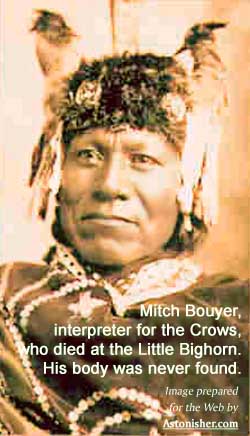|
||||||||||||
Bruce Brown's 100 Voices... Thomas LaForge's Story of the Battle
STATEMENT OF THOMAS H. LaFORGE
"Early on the morning of June 26th, I saw a camp fire across the river from the camp. I saw a horse near the fire, and then I saw a man. I recognized the man as the scout Curley, and he asked me, in a sign language, where the steam-boat was. I pointed up the Big Horn. He also asked where our command was. I told him they had gone up the river. He soon mounted his horse and rode in the direction I had indicated. "Several years after the Custer Battle I talked with a Sioux Indian who was visiting the battle field. He told me that the scout, Mitch Boyer [Mitch Bouyer], was shot in the back near the Little Horn River. Boyer's back was broken, and he lay suffering during the battle. After the command had been wiped out the Sioux found Boyer still living. Boyer told him that though they had killed those few soldiers there were many thousands more who would come and kill the Indians and conquer them all. He asked to be killed, to be put out of his misery. The Sioux said that he killed him, took off his vest and threw him in the river. Boyer's vest, made of the skin of a spotted calf, was found near the river after the battle." The Custer Battle Book by Herbert Coffeen, A Reflection Book, Carlton Press, Inc., New York, 1964 p 47 - 48
Thomas LaForge, also known as Horse Rider, was a scout for the Sixth Infantry. He was not at the Battle of the Little Bighorn -- according to Walter Mason Camp, he went on sick leave June 24 -- but he arrived at the Little Bighorn shortly thereafter. He heard the stories from the survivors when they were still fresh, and he saw the condition of the battlefield first hand. His comment about Mitch Boyer's calf-skin vest is an exrtremely valuable eye-witness observation. LaForge's story about Bouyer largely agrees with Arapaho warrior Sage's account of a badly wounded Mitch Bouyer begging to be killed on the banks of the Little Bighorn before the Sioux accomodated him and threw his body into the river. It also agrees with Pretty Shield -- who said that Bouyer was shot out of the saddle in the middle of the Little Bighorn River during Custer's initial charge at Medicine Tail Coulee -- inasmuch as Sage and LaForge implied that Bouyer's body was found in the river along with that of "the bugler." In fact, the two stories fit together like two pieces in a jigsaw puzzle, for it's possible that the badly wounded Bouyer was able to drag himlself to shore after he was shot in Custer's charge at Medicine Tail Coulee, and then was subsequently found by the Sioux, begged to be killed, was finished off, and finally thrown back in the river. The Americans never found Bouyer's body, but LaForge said Bouyer's distinctive calf-skin vest was found "near the river after the battle," and George Glenn said the Seventh Cavalry burial detail found "the body nearest the river was that of the chief trumpeter [Henry] Voss." See Who Killed Custer -- The Eye-Witness Answer for more info. For more information on Custer's scouts, please see The Twisted Saga of the Unsung Seventh Cavalry Scouts. -- Bruce Brown
|
||||||||||||




 IN APRIL, 1876, I was enlisted as a scout with Barney Bravo and twenty-three Crows, under Gen. Gibbon, and served with E Company, 7th infantry in a mounted detachment under command of Lieut. Bradley. We were enlisted at Crow Agency, Mont.
IN APRIL, 1876, I was enlisted as a scout with Barney Bravo and twenty-three Crows, under Gen. Gibbon, and served with E Company, 7th infantry in a mounted detachment under command of Lieut. Bradley. We were enlisted at Crow Agency, Mont.







